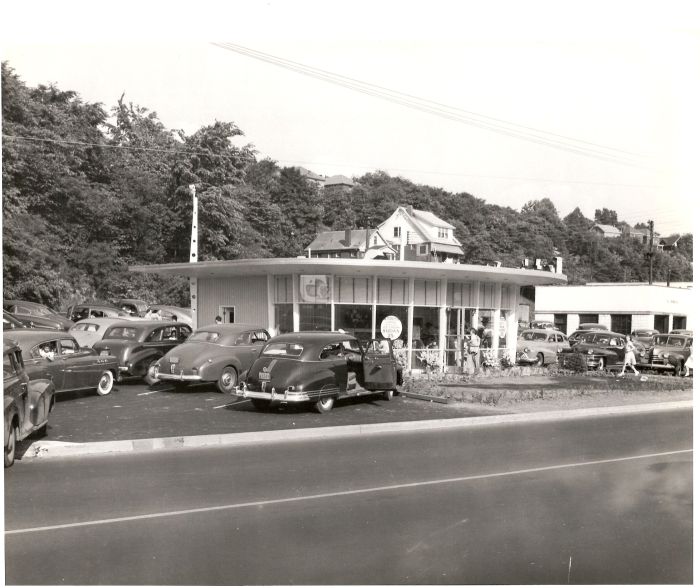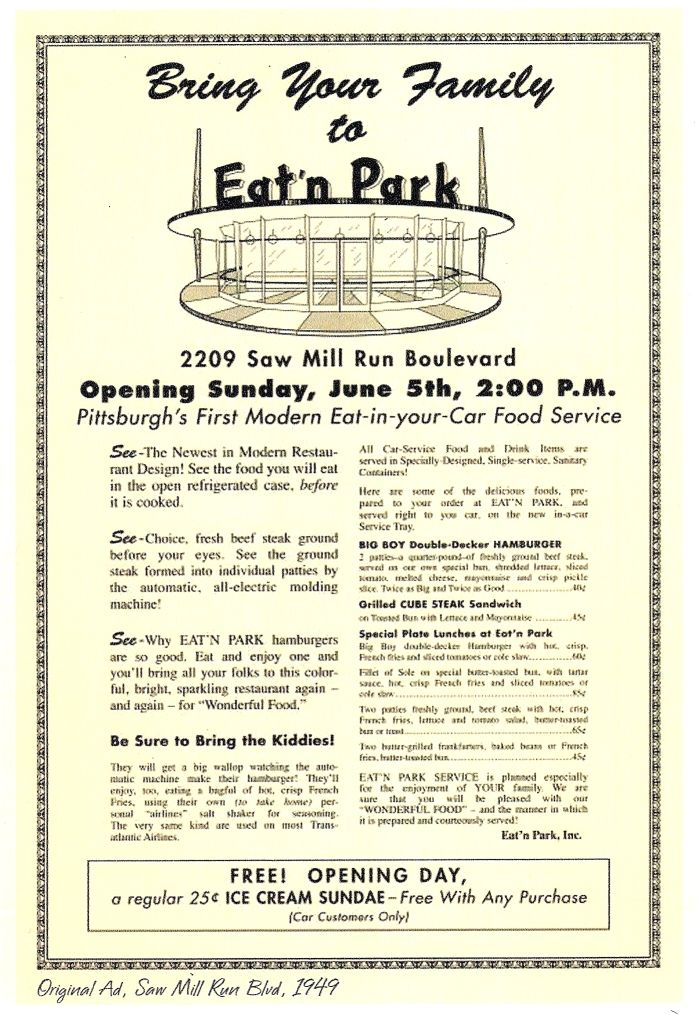Difference between revisions of "Eat 'n Park"
| Line 1: | Line 1: | ||
| − | |||
== This is the first location of the famous Eat 'n Park Restaurant chain. This is located on Saw Mill Run Boulevard and is currently Frank and Shirleys Restaurant. == | == This is the first location of the famous Eat 'n Park Restaurant chain. This is located on Saw Mill Run Boulevard and is currently Frank and Shirleys Restaurant. == | ||
| + | |||
[[Image:Overbrook First Eat'nPark-resized.jpg]] | [[Image:Overbrook First Eat'nPark-resized.jpg]] | ||
| + | |||
| + | '''This is the very first Eat'n Park on opening day in 1949''' | ||
| + | |||
| + | [[File:Eat'n Park Menu only.jpg]] | ||
| + | |||
| + | '''This is the first menu from Overbrook's Eat'n Park''' | ||
| + | |||
| + | |||
| + | == From the Eat 'n Park website [http://www.eatnpark.com/aboutUs.asp click here]. == | ||
| + | |||
| + | Beginnings | ||
| + | |||
| + | Eat'n Park began nearly a half century ago as the first Pittsburgh-area drive-in restaurant with carhops. The carhops are gone now, and our look has changed quite a bit since then, but one thing remains the same — our commitment to great food at an exceptional value while providing outstanding service. | ||
| + | |||
| + | On June 6, 1949, Eat'n Park began with a revolutionary concept. Led by Larry Hatch, an executive of the Isaly Company of that era, a group of Pittsburghers built a tiny, two-tone yellow, 13-seat restaurant in Pittsburgh's suburban South Hills and, at 2:00 p.m., sent 10 bustling carhops out to serve customers right in their cars. And what a revolution it was. The restaurant was so busy that it caused an enormous traffic jam on Saw Mill Run Boulevard and had to close to regroup a scant six hours after it opened. But the votes were in and the die was cast. Eat'n Park, one of the area's first carhop restaurants, was a smash hit. | ||
| + | |||
| + | |||
| + | Through the years | ||
| + | |||
| + | Four months later, the young company opened a second Pittsburgh restaurant. Within 11 years, the chain had grown to 27 restaurants. | ||
| + | |||
| + | What had begun as a phenomenon, would become an institution. Fifty years since that memorable first day, Eat'n Park has grown to be the leading full-service restaurant chain in the tri-state area, with over 75 restaurants throughout Pennsylvania, West Virginia, and Ohio, and over 8,000 employees. | ||
| + | |||
| + | Eat'n Park has succeeded in changing with the times. New trends in customer preferences have prompted shifts in dining style, exterior and interior building designs, menu selections, and employee training programs, all with the primary objective of quality service in mind. | ||
| + | |||
| + | |||
| + | Why Not Park'n Eat | ||
| + | |||
| + | The secret to Eat'n Park's original success was innovation. The original carhop concept was developed by Mr. Hatch, who understood in 1949 that cars meant the future and that the Pittsburgh area needed a restaurant to capture the spirit of the times. | ||
| + | |||
| + | It also needed a name that matched its function. Logically, a customer parked first then ate -- either in or out of the restaurant. However, in the late 1940's, "Park & Eat" was as common a sight as "Drive Thru" is today and could not be copyrighted. | ||
| + | |||
| + | In a brainstorm, Hatch and company decided to reverse it -- to Eat'n Park. The catchy name stuck, so much that while the once everywhere "Park & Eat" signs have virtually disappeared from American highways, "Eat'n Park" remains a tri-state tradition, even though the name no longer describes the restaurant's dining style. | ||
Latest revision as of 11:53, 16 November 2011
This is the first location of the famous Eat 'n Park Restaurant chain. This is located on Saw Mill Run Boulevard and is currently Frank and Shirleys Restaurant.
This is the very first Eat'n Park on opening day in 1949
This is the first menu from Overbrook's Eat'n Park
From the Eat 'n Park website click here.
Beginnings
Eat'n Park began nearly a half century ago as the first Pittsburgh-area drive-in restaurant with carhops. The carhops are gone now, and our look has changed quite a bit since then, but one thing remains the same — our commitment to great food at an exceptional value while providing outstanding service.
On June 6, 1949, Eat'n Park began with a revolutionary concept. Led by Larry Hatch, an executive of the Isaly Company of that era, a group of Pittsburghers built a tiny, two-tone yellow, 13-seat restaurant in Pittsburgh's suburban South Hills and, at 2:00 p.m., sent 10 bustling carhops out to serve customers right in their cars. And what a revolution it was. The restaurant was so busy that it caused an enormous traffic jam on Saw Mill Run Boulevard and had to close to regroup a scant six hours after it opened. But the votes were in and the die was cast. Eat'n Park, one of the area's first carhop restaurants, was a smash hit.
Through the years
Four months later, the young company opened a second Pittsburgh restaurant. Within 11 years, the chain had grown to 27 restaurants.
What had begun as a phenomenon, would become an institution. Fifty years since that memorable first day, Eat'n Park has grown to be the leading full-service restaurant chain in the tri-state area, with over 75 restaurants throughout Pennsylvania, West Virginia, and Ohio, and over 8,000 employees.
Eat'n Park has succeeded in changing with the times. New trends in customer preferences have prompted shifts in dining style, exterior and interior building designs, menu selections, and employee training programs, all with the primary objective of quality service in mind.
Why Not Park'n Eat
The secret to Eat'n Park's original success was innovation. The original carhop concept was developed by Mr. Hatch, who understood in 1949 that cars meant the future and that the Pittsburgh area needed a restaurant to capture the spirit of the times.
It also needed a name that matched its function. Logically, a customer parked first then ate -- either in or out of the restaurant. However, in the late 1940's, "Park & Eat" was as common a sight as "Drive Thru" is today and could not be copyrighted.
In a brainstorm, Hatch and company decided to reverse it -- to Eat'n Park. The catchy name stuck, so much that while the once everywhere "Park & Eat" signs have virtually disappeared from American highways, "Eat'n Park" remains a tri-state tradition, even though the name no longer describes the restaurant's dining style.

